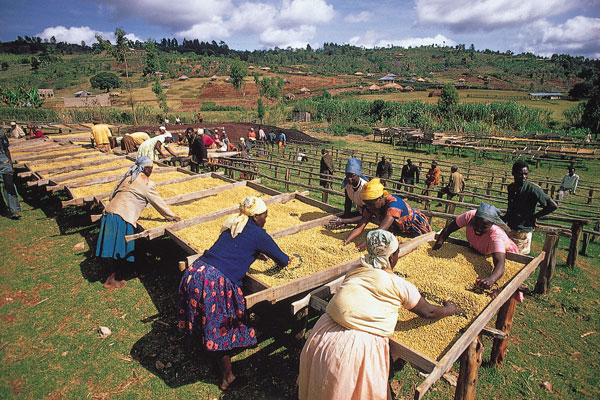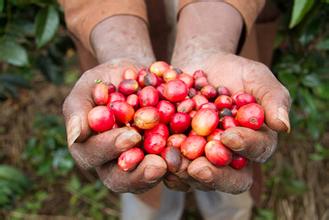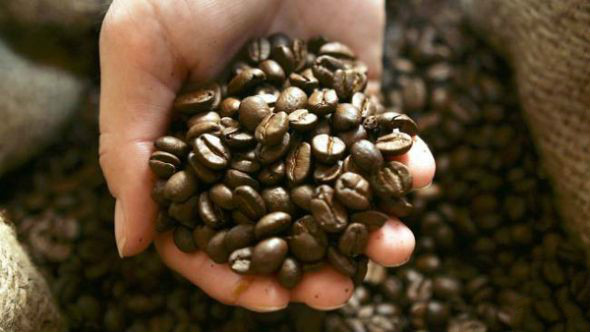Introduction to the types of Coffee and the practice of all kinds of Coffee in Kimmel Manor, Papua New Guinea, hand-made coffee
Main points: see that some friends say to buy coffee powder directly, I personally recommend people in large and medium-sized cities, it is better to buy fresh coffee beans and grind them themselves. To make a good cup of coffee, the most fundamental thing is to have fresh and high quality coffee beans.
If you buy better by hand mill, you can make sure that the coffee powder is evenly ground. If the grinding is not uniform, it will make the coffee taste not "pure". Because of the different contact area, hot water extracted from coarser coffee powder is much less than from fine powder at the same time. When the extraction time is just enough to fully extract the "good taste" from the coarse powder, it is already over-extracted from the fine powder-there will be some flavors that we do not want to appear. The main purpose of hand-made single product is to taste the original flavor of coffee, and it is to enlarge a certain characteristic of coffee flavor to taste it carefully. Therefore, we should try our best to ensure that the extraction is uniform rather than mixed with various flavors.
water. Now everyone pays attention to the soft water for drinking water, and the soft sailor tastes better. The water temperature is 85-95 degrees Celsius, too high temperature will cause coffee to have a scorched taste, and too low temperature will give coffee an unpleasant sour taste (just right coffee will also have a light sour taste, but this sour taste is pleasant, such as light fruit acidity.)
Pay attention to the warm cup. All utensils used in the process of hand brewing should be kept warm so that the taste of the coffee is warmer and moist.
The thin-nosed pot for hand flushing can be purchased separately, or you can choose some common utensils instead, as long as you ensure that the flushing flow is fine and stable. Of course, try to keep warm as much as possible.
According to my experience, 250 milliliters of coffee for every 15 grams of coffee powder is an appropriate proportion.
The rest is some simple process: put the filter paper into the filter bowl, add a small amount of water, let the filter paper "serve", and there is no air bubble between the filter paper and the filter bowl; grind the coffee powder and load it evenly (this process is called cloth powder. Some people think that the uplift in the middle of the powder pile can make better coffee, while others think that a hole should be dug in the middle of the powder pile. This depends on personal understanding); slowly flush the hot water of about 92 degrees into the coffee powder, controlling the amount of water to drop just one drop from the bottom of the powder pile; let the coffee powder fully absorb the hot water for about 40 seconds (at this time, if the coffee powder is fresh enough, you will see the coffee powder obviously expand); empty the containers that hold the coffee under the filter bowl (including the hot water for the warm cup and the drop of hot water just dropped for soaking the coffee) The water temperature dropped to about 90 degrees in these 40 seconds, just right for the start of hand flushing; slowly flushing water and drawing circles in one direction from the center of the powder pile, circle after circle. All right, drink it.
Country: Papua New Guinea
Grade: grade A
Producing area: Wiki Valley
Altitude: 1500 m
Treatment: washing
Varieties: Arusha, BlueMountain, Catimor
Producer: Kimmel Manor
Flavor: nuts, sucrose, low acid and solid
Located in the east of the Indonesian archipelago, Papua New Guinea, which is dominated by highlands, has a pattern of large manors / farms and small farmers, growing a variety of coffee varieties. The coffee flavor of Papua New Guinea is very different from that of other Asian regions such as Indonesia, South Asia, India or the Pacific Islands. compared with Indonesian beans (Sumatra, Sulawesi) which are mostly semi-washed (wet peeling), they show low acidity, mellow texture and soil conditioning.
Papua New Guinea, to the east of Indonesia, has a standard island climate, located between the equator and 10 poisonous latitudes, with tropical rain forest volcanic rocks and plateau topography, between 1200 and 2500 meters above sea level, making it a paradise for growing coffee. The local yield is small, and about 85% of the total coffee is produced by the garden cultivation system of small farmers. Small farmers join local cooperatives and share their processing equipment. Coffee is Pakistan's second largest export of agricultural products, which shows the importance of coffee industry to Pakistan's economy. Because the variety of coffee is different from that of Indonesia, and the altitude is higher than Sumatra, coupled with the use of water washing treatment, the regional taste of PNG coffee is different from Indonesia's muggy and low flavor, but has bright, sweet and sour, flower and fruit aromas, similar to the flavor of South America.

Important Notice :
前街咖啡 FrontStreet Coffee has moved to new addredd:
FrontStreet Coffee Address: 315,Donghua East Road,GuangZhou
Tel:020 38364473
- Prev

The production method of Aceh hand-brewed Coffee in Sumatra, Indonesia
Main points: see that some friends say to buy coffee powder directly, I personally recommend people in large and medium-sized cities, it is better to buy fresh coffee beans and grind them themselves. To make a good cup of coffee, the most fundamental thing is to have fresh and high-quality coffee beans; hand mill to buy better, can ensure that the coffee powder is uniform. If the powder is not evenly ground, it will make the coffee taste.
- Next

Introduction of imported coffee with Indonesian cat droppings coffee beans and the practice of all kinds of coffee hand brewed coffee
Main points: see that some friends say to buy coffee powder directly, I personally recommend people in large and medium-sized cities, it is better to buy fresh coffee beans and grind them themselves. To make a good cup of coffee, the most fundamental thing is to have fresh and high-quality coffee beans; hand mill to buy better, can ensure that the coffee powder is uniform. If the powder is not evenly ground, the coffee will not taste good.
Related
- Detailed explanation of Jadeite planting Land in Panamanian Jadeite Manor introduction to the grading system of Jadeite competitive bidding, Red bid, Green bid and Rose Summer
- Story of Coffee planting in Brenka region of Costa Rica Stonehenge Manor anaerobic heavy honey treatment of flavor mouth
- What's on the barrel of Blue Mountain Coffee beans?
- Can American coffee also pull flowers? How to use hot American style to pull out a good-looking pattern?
- Can you make a cold extract with coffee beans? What is the right proportion for cold-extracted coffee formula?
- Indonesian PWN Gold Mandrine Coffee Origin Features Flavor How to Chong? Mandolin coffee is American.
- A brief introduction to the flavor characteristics of Brazilian yellow bourbon coffee beans
- What is the effect of different water quality on the flavor of cold-extracted coffee? What kind of water is best for brewing coffee?
- Why do you think of Rose Summer whenever you mention Panamanian coffee?
- Introduction to the characteristics of authentic blue mountain coffee bean producing areas? What is the CIB Coffee Authority in Jamaica?

